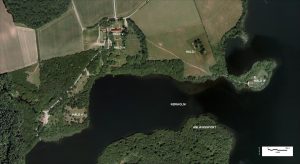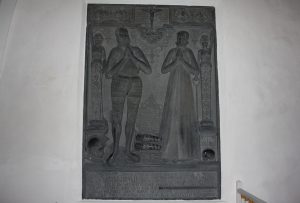HALD CASTLE 1536-1662
By Ole Degn, Viborg
For almost 130 years Hald Castle was the centre of a royal fiefdom in Jutland: Hald Len. Through written sources and archaeological finds, it is possible to arrive at a close-up picture of the administration and day-to-day life at Hald Castle in the 16th and 17th centuries. In 1662, the royal fiefdoms were transformed into new administrative districts of shires [Da: amt] and Hald Len thus became Hald Amt. The actual manor itself was sold in 1664 to the de Lima brothers, when the Crown sold off large parts of its possessions to cover the enormous debt that had resulted from the prolonged warfare with Sweden.

This aerial view shows an overview of the five castle, rampart and manor facilities which were around Hald Sø during the time. The five facilities are traditionally called Hald I-V. However, the chronological order of the facilities is II-III-I-IV-V. Photo: From the anthology Castles at War article by Jesper Hjermind.
The establishment of Hald Len in 1536
The introduction of the Reformation in 1536 led to seizure of the Catholic Church’s possessions. The old bishop’s palace of Hald and the appurtenant estate became Hald Len – one of 51 main royal fiefdoms. In charge was a nobleman, who held the fiefdom by royal appointment. He held the title of royal bailiff [Da: lensmand] and had a dual function. Part of his job was to manage the estate and copyhold farms [Da: fæstegårde] belonging to the king in the fiefdom, the crown land; the other involved a number of authoritative tasks in relation to the population within the district of the fiefdom.
The headquarters was located on the banks of Hald Lake in the former bishop’s palace, which was now called Hald Castle, the centre of a huge area that stretched from the Limfjord in the north southward in a semicircle, east and west around the city of Viborg. The whole island of Mors was also part of the fiefdom. In geographical terms, Hald Len was one of the largest in Denmark. Also attached to Hald Castle were a number of copyhold farms, which were initially scattered over a very large area in Jutland.
The royal bailiff

Mural monument from Tjele church over councilor Jørgens Skram (1534-1592) and his wife Hildeborg Daa (1549-1595). Jørgen Skram was the royal bailiff of Hald fief from 1585 to his death in 1592. Photo: Wikimedia Commons.
The royal bailiff was manager of the crown land. It was his job to make sure that the buildings on the copyhold farms were maintained, that the fields were cultivated and that the forests were not over hewed. He had to make sure that the farms were occupied and not deserted. He had to make sure that the peasants abided by the law, but he also acted as their defender in the event of grievances. He was the Kings representative in lawsuits and transactions. Last but not least, he collected the king’s taxes.
Hald Len gave the king a huge amount of revenue: primarily from the rent-paying copyhold farms which paid an annual rent in goods and money [Da: landgilde]. Revenue also resulted from the start of a new tenure [Da: stedsmål], fines from lawsuits [Da: sagefald], various types of customs duties and the so-called “extraordinary” taxes, which became increasingly frequent. Hald Len had to collect royal taxes both from the tenants serving under the fiefdom, from tenants serving under minor fiefdoms or under the clergy and the nobility, and from ‘freehold’ peasants.
The royal bailiff also served as the king’s representative in a number of functions. This included publication of royal regulations, the appointment of district bailiffs and other official business. He made sure that breaches of the law were prosecuted and fines were paid. In his capacity as intermediary between the central administration in Copenhagen and the local administration, he had to provide the king with information in the form of letters and reports. He supervised the market towns and certain military functions, thereby making sure that the nobility fulfilled their obligation to charge knights to military service.
The creation of the new office of “diocesan bailiff” [Da: stiftslensmand] transferred the secular functions from the former Catholic Church to the fiefdom. The royal bailiff at Hald henceforth had to serve as defender of the Church’s priests and property. He collected the king’s share of the former bishop’s tithe and made sure that revenue from the churches were deployed correctly.
Hald Castle – a royal administration centre
The fiefdom’s headquarters at Hald Castle was an important centre in Central Jutland. From the collection of the king’s taxes to the broad range of administrative tasks, Hald Castle had both direct and indirect relations to nearly everyone within a huge area.
The buildings at Hald reflected the size and importance of the fiefdom. Surrounded by huge ramparts, Hald Castle was established in the former bishop’s palace. This was where the royal bailiff’s house and various administrative functions were located.
Outside the ramparts was the home farm with stables and barns. This was the centre for farming on Hald’s own lands and livestock, fishing in the lake and hunting in the forests, along with the busy toing and froing of carts delivering taxes in kind and fetching or bringing goods.
The royal bailiffs at Hald 1536-1662
During the period 1536 to 1662, a total of 17 royal bailiff’s inhabited Hald Castle. The appointment was always given to men of noble birth and was a coveted one, both financially and in terms of status. The office yielded huge income, and the royal bailiff was often a member of the highly distinguished privy council of the realm.
Together with the king, the council formed the country’s government. As many as seven sat in the council of the realm, while holding the post at Hald. In the course of their careers, they had generally served at court, in the army or in the central administration. For some of them, Hald Len was their first, but others had already held other fiefdoms. Transferring experienced royal bailiffs from other places or other parts of the country meant that the administration at Hald benefited from significant expertise.
Unlike the later sheriffs [Da: amtmand], the royal bailiffs were often born in nearby areas of Jutland. Nearly all of them also owned a manor in neighbouring districts.
The decommissioning of Hald Len
In 1662, Hald Len became Hald Amt, and the administrative functions and authorities were transferred to a sheriff. In 1664, the actual Hald Castle, along with its farmland, forests and copyhold farms, was sold to the de Lima brothers, when the Crown sold off large parts of its possessions to cover the enormous debt that had resulted from the devastating wars with Sweden 1640-1660.



